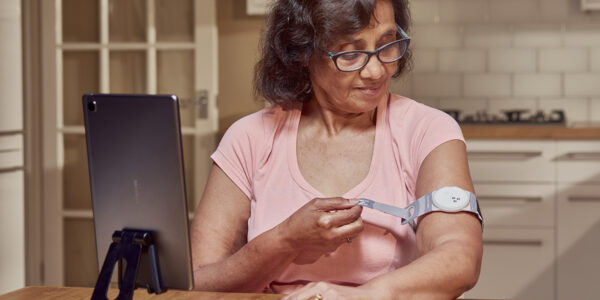Oxford Health is trialling the use of smart monitors known as ‘wearables’ with some of its Hospital@Home patients so that clinicians can check vital signs remotely, enabling them to act if a condition deteriorates.
The device allows round-the-clock monitoring of heart rate, oxygen levels, breaths per minute, skin temperature and movement which will tell the clinician whether a patient is stable. Blood pressure monitors and weighing scales can also be added on.
During the pilot they will be worn by selected H@H patients, who tend to be fragile and more dependent and need to be monitored to ensure their condition remains stable in the community. All patients will still be seen face-to face.
Bharati Aggarwal is the Digital Lead for Community Therapy. She said: “I am very excited both about digital technology and about this project and how it can help people. The use of digital technology is already changing the face of healthcare and I think it will continue to do so but the patient will always come first.
“Our aim is to establish a system where both clinicians and patients can feel confident with wearables, knowing that all the necessary health checks that healthcare professionals would normally carry out face-to-face are still being performed. These devices offer continuous monitoring and by using them we should be able to identify problems earlier and take appropriate action. In the future it would be our aim to enable GPs to see their own patient’s data on the dashboard as well.”
Sue Palmer, Clinical Lead of the Hospital at Home service is participating in the project. “It’s really important that the pilot collects feedback from both patients and staff alike. We need to not only understand the patient’s experience of wearing the remote monitoring device; but also gather data from staff who are involved in its implementation,” said Sue.
She added: “We also need to be able to explain how this technology can help shape patient care which will support future decisions about which equipment and tech we may want to use.”
H@H clinicians will check the dashboard prior to visiting the patient and if required, will liaise with the patient’s GP and any other specialists or NHS services to ensure that the patient receives a holistic approach to their care.
The study will be able to monitor up to 17 patients at any one time. It is not possible for patients, their families or GPs to refer people to the study – all cases are referred via H@H.
Published: 9 August 2022

